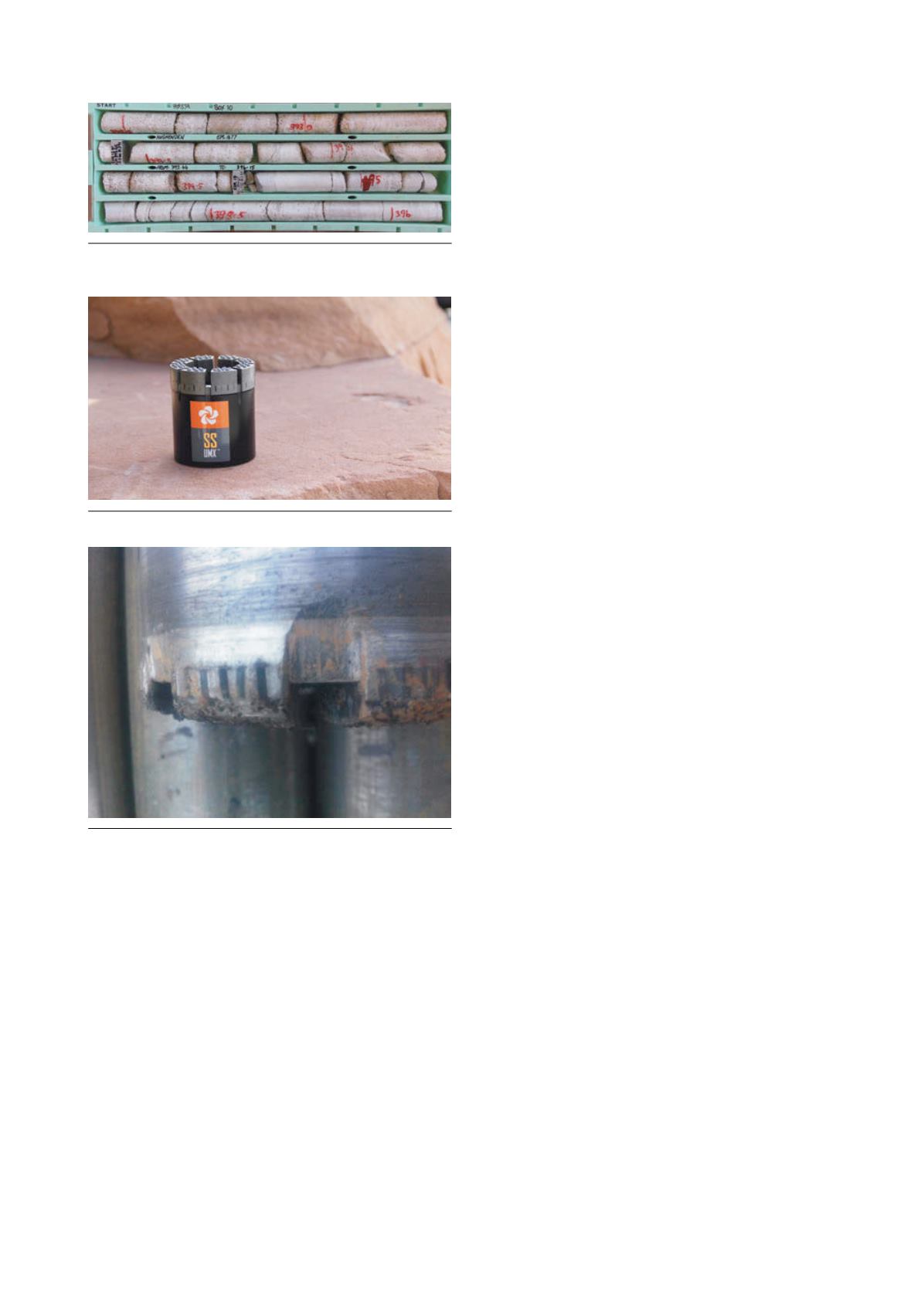
impregnated bits because they can be made very
wear-resistant, and new diamonds can be exposed as the initial
layer is worn out.
Quartz, or silica, is the most common hard material,
composing approximately 43% of the earth’s crust. Silica
accumulates over geological time for two reasons: one, it is
relatively inert chemically so it does not weather, and, two, it is
hard so it tends to break down other materials rather than being
broken down. This abundance makes it readily available to be
deposited in quartz veins or bands through hydrothermal or
magmatic processes. Encountering quartz veins is a relatively
common occurrence in coal exploration. Due to its hardness
(Mohs 7) and its crystalline structure, quartz would be best cut
using a free-cutting impregnated bit. Surface set bits struggle to
get penetration rate and life in rock this hard.
Based on the conditions above, it is clear that at least two
different bits are required to drill productively and, until
recently that is exactly what contractors would use. A surface
set bit would be used in clays and shales. The driller would
then trip out and install an impregnated bit when hard rock
was encountered. What is needed is a bit versatile enough to
cut quartz freely, have good life in broken, abrasive conditions
and produce good penetration rates in clays and shales.
Meeting demand
These extreme drilling conditions require extreme
performance. To meet the demand for extreme performance,
Boart Longyear developed the first UMX™ (Ultramatrix™)
diamond bit series, SSUMX. Using patented metallurgy and
scientific research, a tough impregnated matrix was developed,
which is capable of supporting synthetic diamonds two times
larger than any used previously. The large size of the diamond
and exposure the matrix can support allows SSUMX to
penetrate, on average, as fast as surface set bits with the largest
stones, six to ten stones per carat, and far better than any other
impregnated bit. More importantly, the wear-resistant matrix
and the renewable diamond of an impregnated bit combine to
yield field-proven bit life increases up to 200% over traditional
surface-set bits. Even more surprising, UMX technology retains
a free-cutting behaviour. When an SSUMX bit hits a quartz
lens, its penetration rate does not decrease, eliminating the
need to pull rods to swap bits, putting more core in the box.
This impregnated bit with large synthetic diamonds exceeds
the performance and reliability of traditional surface-set
diamond bits and the versatility of other impregnated bits.
Unlike surface set bits, impregnated bits do not arrive with
diamonds exposed, so they need features to aid with diamond
exposure and to keep the bit drilling straight initially.
Traditional impregnated bits have grooves or race tracks on the
face, which increase initial wear and speed exposure of the
diamonds. SSUMX has a more wear-resistant matrix than a
typical impregnated bit. In soft conditions, this would mean
that the bit would take longer to become sharp, if it had the
traditional race track face profile. SSUMX needed something
different to cut right out of the box and be competitive with
surface sets. The bumps of the Razorcut™ face design provided
the answer. Unlike grooves, the bumps act like cutters,
allowing good penetration rates – even in sandstones – until
the diamonds expose.
In addition to all the field benefits, SSUMX also simplifies
ordering. Surface set bits have wide variations in diamond size,
diamond grade and total number of carats. All of these factors
play a significant role in penetration rate and bit life – and yet
they may not be clearly specified by manufacturers. The one
SSUMX formula covers it all. On top of this, surface set bits
traditionally had many different profiles to try and optimise
performance of the single layer of diamonds. SSUMX only needs
a flat face and on those rare occasions when needed for core
recovery, a stepped OD profile. SSUMX is available in all the
standard core barrel sizes and systems, Q™, Q3 QTT and the
new double tube piloted lifter case, Q-P.
SSUMX has been put to work in coal exploration all around
the world, so no matter where an operator is drilling, SSUMX
will work for them. Case studies from easternAustralia, eastern
US and SouthAfrica demonstrate that SSUMX impregnated bits
will last longer, cut faster and be more cost-effective than any
Core sample of quartz band from Galilee Basin, Queensland,
Australia.
Versatile SSUMX™ impregnated coring bit.
Limited OD wear on SSUMX™ impregnated coring bit after
reaming the hole.
36
|
World Coal
|
June 2016


